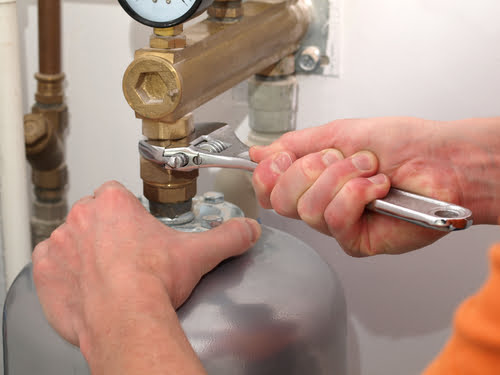
In the past, we’ve written blogs that discussed the difference between tankless water heaters and the hot water tank. We were trying to give Calgary homeowners a good overview of the pros and the cons of owning a tankless water heater. If you didn’t catch the blog when we posted it, you can read about whether tankless water heaters are worth the money here. For those of you who haven’t made the change, it’s probably time to clean out your hot water tank.
Some Calgarians are no doubt wondering why they need to clean out hot water tank at all. But, just like your tub collects soap scum, your hot water tank collects sentiments and needs to be cleaned out in order to function at peak condition. This once a year cleaning can add years to your tank, and we don’t need to tell you how expensive a new tank can be! This is a job for the skilled and handy DIYer, but you may also just want to call in a professional plumber, so if you don’t feel comfortable doing it yourself, don’t hesitate to phone us.
Step One is to turn off the heat to your tank. It’s a good idea to complete this step a few hours (or all night if you can) before the actual cleaning process. That way you won’t burn yourself. Depending on your home and electric water tank, you may have to shut off the heat for your whole house. Every home is different, so if you can’t identify how to turn your tank’s power off yourself, you can either give us a call or just turn off the main power supply. Turning the main off, will definitely cut heat and power to your whole home though. It’s one of the reasons spring or summer is the best time to do this job.
Many Calgarians have gas or natural gas water heaters. If you’re one of them, make a note of your current temperature setting then turn the thermostat on your water heater to its lowest setting often called “pilot”. When you’re finished cleaning out the tank, you’ll want to know what temperature to return the thermostat to.
Step Two is to prep for draining. To start off you’ll want turn off your cold water supply. It should be located near the cold water inlet pipe at the top of your tank. Rotating clockwise should shut the water off. In order to prevent a vacuum from happening when you start to drain the water, you’ll want to open the hot water faucet on a large sink or your bathtub. Finally collect a garden hose or three.
It’s now time to decide where you’re going to put all that water. If you shut the heat off last night, you’ll have the option to save the water in buckets for the garden or to have the hose empty onto your lawn. If the water is still hot, you’ll need to release it directly into a drain or on your driveway. Which ever option you decide, it’s a good idea to test your hose (or hoses) to make sure you won’t have water sprayed all over your house. Remember hot water may melt buckets and weaken your garden hose, be extra careful if you don’t have the time to cool the water.
Step Three is to actually clean out the sediment. Once your hose is secure and your bucket (or other draining location) is ready, you can open the drain cock. Try to drain the water slowly since you’ll get more sediment that way and hopefully won’t have to drain it a second time. We’re going to warn those who didn’t take the time to let the water cool once more that the water is going to be Extremely Hot. It’s also important to note that you should never force the drain cock. If you do, it may break, and we promise that is not a situation you want to find yourself in. Every five minutes or so, you’ll want to do a test bucket. Once your test bucket is filled, let it sit for several minutes. If the water is discoloured or you can see sediment collecting at the bottom, there’s more work to do. Once your test bucket comes out clear and without sand, you know you’re done. If you empty your entire tank and it’s still coming out gunky, you’ll want to turn off the drain cock and reopen the cold water supply. When the tank is mostly filled, start draining again until the water comes clear.
At this point your water tank is clean, and it’s time to get it ready to hold hot water again. We’ll be covering that in our next blog so stay tuned. Don’t want to wait until next month? Call Plumbing Paramedics today with your questions or have us come in and clean your water tank for you!
Call us at (403) 452-2911 or Book Now an appointment.
When to Call a 24 Hour Plumber
Plumbing problems can strike at any time, often when you least expect them. A leaking pipe or a malfunctioning water heater can quickly turn into a full-blown emergency that needs immediate attention. Knowing when to [...]
Effective Drain Cleaning Techniques
Maintaining clean and clear drains is vital for the smooth operation of your plumbing system. Clogged or slow drains can lead to a host of issues, including unpleasant odours, slow water drainage, and even serious [...]
How Our Emergency Plumbers Handle Urgent Repairs
Plumbing emergencies can occur without warning, causing significant inconvenience and potential damage to your home. From burst pipes to sudden leaks, these issues require prompt and professional attention. Our emergency plumbers are ready to respond [...]






